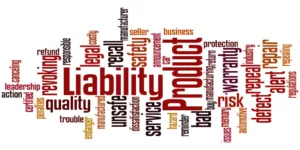Liability is always a concern when manufacturing products. When products cause injuries or deaths, the manufacturer is likely to blame. Aside from the moral concerns, such liability claims can bankrupt a company.
“Defective and dangerous products are responsible for millions of injuries every year in the United States,” says injury attorney George Bochanis. “Thousands of people are killed as the direct result of using products such as defective children’s toys, toxic prescription medications and faulty automotive parts.”
Ensuring your products are safe from risks can feel like a daunting and impossible task, but there are steps you can take to help reduce the risk of liability.
1. Better Management of Supplies and Imported Goods
If your company imports products, parts, raw materials or sub-assemblies, you may be held responsible for any defects in these components. It is your responsibility to verify that the imported product is in compliance with government regulations and industry standards. You must also ensure that the components contain the appropriate instructions, warnings and labels for end users.
Proper management of supplies and imported material is essential. Gather all of the pertinent information from suppliers related to any imported goods.
2. Transfer Risk Through Better Supplier Management
Risk transfer programs help protect companies against financial vulnerability related to claims and damages. Without a risk transfer program in place, decisions related to liability are often made after the fact and typically in court.
Having a written and signed legal agreement in place that transfers risk will help protect your company. It’s best to work with a lawyer to draft these agreements at the beginning of a business relationship.
Transfer risk programs should include two important things: statements of financial responsibility and hold harmless agreements.
Obtaining certificates of insurance will help your company avoid being held financially responsible for product-related claims. They serve as proof that the supplier or contractor has the appropriate insurance in place to cover a claim.
Hold harmless agreements provide your company with explicit protection. They ensure that suppliers and contractors are responsible for their own negligence, omissions and/or errors in the event of a claim.
3. Document Everything
Documentation can help save a company from financial ruin in case of a product liability claim. Create and implement documentation policies that meet regulatory requirements and business objectives. These policies should also be created with the possibility of liability claims in mind.
Establish written instructions and procedures that detail the flow of the product, from the manufacturing process through the quality control segment. Documentation will not only verify the quality of your products, but also help ensure conformity when developing products.
Keep copies of product orders and customer design specifications, including signoffs on final designs. Implement a system that also documents any changes to design or manufacturing process, so that there’s a clear explanation for the change.
Have a document retention policy in place to preserve these essential documents should a liability claim ever arise.
4. Make Safety a Core Priority in Design
Many safety risks can be mitigated in the design phase. When designing new products, have a safety review performed. The review should take into account how the product should be used and which risks may arise due to the product’s use.
Make sure that your products:
- Comply with government and industry safety standards
- Contain instructions, labels and clear warnings
The safety review should also confirm that your products adhere to these standards. If products do not meet these standards, take steps to make changes before putting the product on store shelves.
5. Review Customer Feedback
Customer feedback can help you correct issues that may not have been found in the design and review phase. Make sure that customers have an outlet to give your company feedback on your products. And make sure that your company actually reviews and assesses that feedback.
Review and investigate customer complaints. Take action if the complaints are warranted. Taking action early on can help you avoid a bigger issue later on down the line.
It may be impossible to completely shield a company form product liability, but taking steps to minimize the risk is important. Transferring risk, managing your suppliers, reviewing customer feedback and having a well-established documentation policy in place will minimize exposure if a claim should arise.








